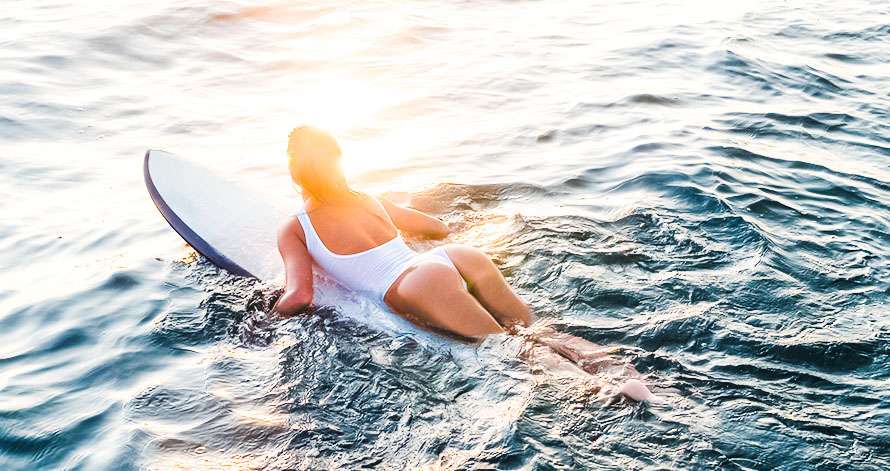Kayaking through surf can be the easiest or hardest thing you ever do in a kayak. Here’s how to maneuver more efficiently through the waves
Launching
Face the ocean with your bow pointed directly at the water. If you wish to make it to the other side of an approaching wave you must maintain a perpendicular angle to it. The larger the wave, the more true this is. If the waves are coming in at an angle, you may need to adjust your launch angle to face the swell directly. While keeping your desired angle, push off the sand with one hand, and with the paddle in your other hand, dig a paddle blade into the sand. This is the most effective and efficient way to launch in a decked kayak. (Sit-on-top kayakers can wade out past the shore break and then hop onto the kayak.) As soon as you are floating, paddle rapidly to make it past the initial shore break. If you get rejected or swept sideways, try to reposition quickly and try again.
TIP: Waves usually come in sets. Try to launch just after the last wave in a set with the goal of making it out before the next set arrives.
Boof
Boofing, a staple of river-running technique, is a method for accelerating over the tops of rolling, peaking, and broken waves (foam piles), and momentum is essential. Paddle aggressively, and at the top one-quarter of the wave, dig (drop one knee and lift the other) one edge of your kayak slightly, and pull a stroke through on the same side as your dropped knee. At this time, lift with your knees by pulling up with your abdominal muscles, pop your hips forward while transitioning to the opposite edge of your boat, and, importantly, keep leaning forward. Proper posture keeps you in control.
When crossing the top of the wave, you might catch a lot of air—intentionally or not. Land slightly on edge and lean forward to lessen the impact on your spine.
The boof becomes more difficult when a wave has broken and you are trying to make it over a foam pile. This time you need to edge much more drastically, digging the rail of your kayak deeper into the water and taking a strong stroke on that same side while lifting your knees with your abdominals (lean forward!). This action will raise your bow, and when the speeding foam pile hits the bottom of your boat you will accelerate up and over it. Two forces—your momentum toward the wave and the wave’s momentum toward you—have just collided, causing you to plane across the wave. But keep in mind that lots of water is being pulled toward the beach in the foam pile, which is trying to pull you backward. As you go up the wave, pull the boof stroke completely through to your hip, while transitioning to the opposite edge of your boat. Quickly take another strong stroke on the opposite side. This should get you mostly across the foam pile. Immediately take a flurry of forward strokes to keep your momentum going. The larger the wave, the quicker you’ll have to stroke right after the boof.
Remember, stay perpendicular to the wave, and start your boof stroke a couple of feet from hitting the foam pile.
TIP: It is advisable for sea kayakers to practice this move on the river, and whitewater kayakers can learn from boofing in the ocean.
Punch and Tuck
This technique comes into play when you reach a wave that has not yet broken but is past vertical. When done correctly you can kayak right through the face of surprisingly huge breaking waves. The thicker the wave, the more difficult it is, and the more power and speed you need. You’ll want to punch and tuck on a wave that is beginning to break over your head as you climb the face. It’s hard to execute at a moment’s notice, so you’ll have to know you’re going to do it before you and the wave meet. Spot a distant wave that is building toward you. As you power forward and up the face, the wave will curl over your head.
Important: Have your bow penetrate the wave where the wall and ceiling meet, then use your momentum to tuck forward as hard as you can while picking up with your thighs and pushing down with your heels. Put your head down, pointing the top of your helmet at the wave. Take one last powerful stroke, punching your leading fist and blade through the wave. Your bow, paddle blade, fist, and head should pop through the backside in that order.
The punch-and-tuck technique can be scary when you have a huge wave barreling toward you, but successfully completing the maneuver will give you more confidence in your ability.
Turtle
This move can be done in all kayaks and is a last resort when you have little or no speed and you are caught in the breaker zone. Again, staying perpendicular to the foam pile will help keep you from being dragged sideways. This is especially important in a long sea kayak. Paddle toward the foam pile and flip over at the last second. To keep from being dragged by the foam pile, extend your body, arms, and paddle as far down into the water as possible to catch outward-flowing current. When the wave passes, roll up and continue paddling.
Last modified: March 12, 2022


